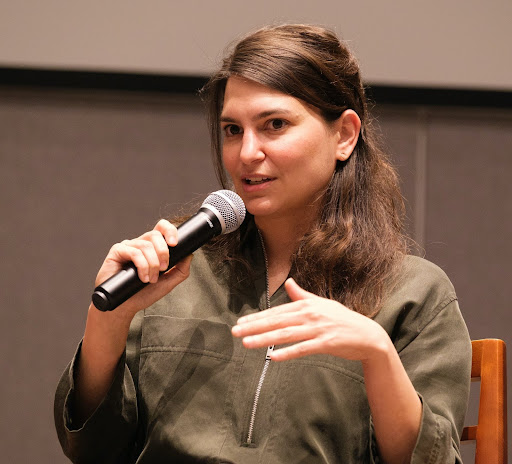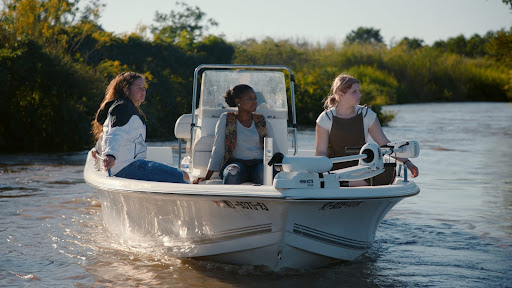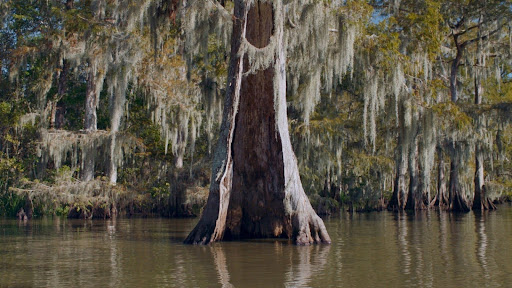Along with being a 2006 Fieldston graduate, Kira Akerman is a documentary filmmaker. Most recently, Akerman finished directing a feature length documentary titled Hollow Tree. This film, which premiered at The Museum of the Moving Image in New York City, follows three teenagers – Annabelle (18), Mekenzie (18) and Tanielma (17) – as they learn about climate change through their sinking homeplace of Louisiana. Hollow Tree combines the education of these three young women through the Mississippi River with their coming of age.
Akerman’s own filmmaking process was a result of her own alternative education, from Bank Street to Fieldston to Wesleyan. She notes that as a white director she must “engage with the process of having become white.”
After Akerman graduated from college in 2010, she moved to New Orleans, Louisiana and worked in the film community there for many years. She began thinking more about water and infrastructure as a New Orleans resident, which eventually led to a short film she directed and produced titled Station 15. The short film follows a high school student, Chastity, who investigates New Orleans’ water pumps and the intense flooding that coincides with it. Akerman stated, “It seemed like there was a bigger project than the short film, and so Hollow Tree is an expansion of the ideas that were seeded in that fifteen minute project: working with three young people instead of one, and working with the entire Mississippi River instead of a city water system.”

So, Akerman continued her journey to discover and share more about the climate crisis through experiential learning. “My idea was to use filmmaking as a classroom, and to try to develop a documentary practice for the climate crisis through experiential learning and observation,” Akerman explained. Not only do Annabelle, Mekenzie and Talielma learn from several experts around the state, but they also learn from each other and the different perspectives they all bring to the project.

Annabelle is white with Cajun roots, Tanielma is Black and Angolan and Mekenzie is a member of the United Houma Nation. Akerman illustrated, “I knew I wanted to work with three young people who came from very different geographical locations in the state, because you can have three very different experiences of the same place depending on how close to the coast you are or how inland you are. I also thought it would be meaningful for the three young people to have different racial and economic backgrounds in order to learn from each other and to tell a fuller picture as to what’s happening in this place.”
Throughout the filmmaking process, the three young women explored Louisiana by reading, studying maps and even interviewing community and family members. They talked to people of varying ages, races, socio-economic backgrounds and forms of expertise – ranging from scholars and crawfishermen to community activists and scientists. Akerman later mentioned that her directorial choices were extremely designed, “I very intentionally didn’t give titles and put lower thirds in the film because I wanted the viewer to follow the emotional arc of the young woman, and not to be making judgements on someone’s expertise based on a title but rather on the information they were imparting.”
Tanielma profoundly noted that “there was a sort of detachment when we’re learning at school. Learning through the documentary was very different because we were engaged. It wasn’t just ‘climate change is happening.’ It’s happening in our backyards, like right next to us, and so it affects us personally. And that’s something that’s missing at school. We just learned these facts, and nobody stopped to talk about how it affected your life and everything about you.”
Hollow Tree’s visuals are also extremely important. Not only is the cinematography beautiful, but also very symbolic. Akerman oriented herself towards considering the framing and the aesthetics as she described thinking about cinema as a medium that is about a frame and an image. She wanted to show infrastructure sites to Annabelle, Mekenzie and Tanielma because they tend not to be accessible to young women, especially young women of color. She said, “Part of my visual language was to make the infrastructure visible, and also to make the landscape visible as a character so you could really see what was happening to it with overhead shots and understand that both from the perspective of the young women on the ground and also from above on a larger scale.”
Later, she described the editing process with a chuckle as a “freaking nightmare trying to figure out.” A result of COVID disrupting and barring planned filming, as well as organizing and reorganizing all the footage taken. However, despite the struggles, in the end a masterpiece was created. In fact, she has even received funding to create a similar series in the same community.

She hopes that Hollow Tree will really get people to reflect, “I think there’s a tendency to think about climate change as very abstract and as a distant future, and there is a lot of fear around how to engage with it. I think Hollow Tree demonstrates how we can learn together from one another (even people who are different from us) and shift our ideas, understandings, and patterns – both individually and collectively. Hopefully that can result in shifting patterns that are oppressive and moving towards patterns that are regenerative.”
Hollow Tree will become available for everyone to watch later this year, and I strongly recommend that everyone immediately view it upon access. In fact, the film will be shown at Fieldston along with a Q&A with Akerman in early 2024. This wonderful story engineered by Akerman (and produced by her fellow Fieldston classmate and alum Chachi Hauser) is nothing short of memorable.
To learn more about Kira Akerman and her career/accomplishments click here.









